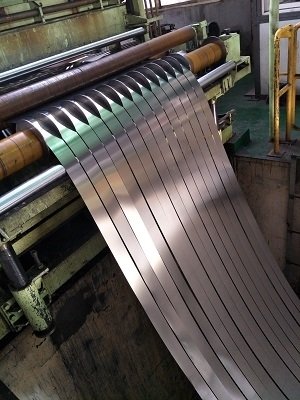
M130-275 steel is a cold-rolled oriented electrical steel. Grain-oriented electrical steel is a special type of steel designed for electrical applications. This steel has a high silicon content and a grain structure oriented by a magnetic field. This makes this steel ideal for use in transformer cores and other electrical equipment where magnetic properties are important.
Grain-oriented electrical steel typically has a silicon content of 2.5% to 3.5%. A higher silicon content makes the steel more magnetic, but also makes the steel more difficult to machine. For this reason, grain-oriented electrical steels are generally only used in applications where their magnetic properties are critical.
One of the main advantages of grain-oriented electrical steel is low loss. Grain-oriented electrical steel can help reduce energy loss by up to 50% when used in transformer cores. This can lead to significant savings for both the utility and the electricity consumer.
Grain oriented electrical steels are also very resistant to thermal cycling. This means they can be used in transformer cores that experience frequent temperature changes without losing their magnetic properties.
What is the chemical composition of M130-275 steel?
M130-275 steel has excellent magnetic properties, the chemical composition of M130-275 steel is:
Carbon C: 0.03-0.05
Manganese Mn: 0.50-0.10
Phosphorus P:≦0.0.10
Sulfur S: 0.015-0.030
Silicon SI: 2.80-3.40
What is the thickness of M130-275 steel?
The nominal thickness of M130-275 steel is 0.27mm
What is the density of M130-275 steel?
Theoretical density 7.65kg/dm³
What is the iron loss value of M130-275 steel?
The iron loss value refers to the total power absorbed by the unit mass material when the magnetic induction intensity changes sinusoidally and its peak value and frequency are specific values.
In electrical equipment with magnetic conductors (hereinafter referred to as iron cores) such as transformers, inductors, AC motors, and alternators, because the magnetic conductors are affected by the changing magnetic field, part of the energy lost in the iron core will be lost. It is lost as heat and sometimes as noise. The iron loss value of M130-275 steel is less than or equal to 1.30 W/kg.
What is the minimum magnetic induction of M130-275 steel?
The minimum magnetic induction of M130-275 steel is 1.82B.
The minimum stacking coefficient of M130-275 steel?
The stacking coefficient refers to the ratio of the real thickness of each silicon steel sheet to the total thickness of the stack after the silicon steel sheet is laminated. For example, 97 means that this ratio can reach 97%. The thinner the silicon steel sheet is, the smaller the stacking factor will be because of the more gaps between the laminations. The minimum stacking factor of M130-275 steel is 96%
What is the process flow of M130-275 steel?
Steelmaking→desulfurization→converter→external refining→continuous casting→slab→slab heating→continuous hot rolling mill→coiling→normalized pickling→rolling→decarburization annealing→high temperature annealing→stretch leveling→annealing and Coating → Magnetocasting Thinning → Finishing Shearing → Packaging
What are the physical properties of M130-275 steel?
Nominal thickness 0.27mm
Tensile strength: 352-427MPa
Elongation 8%
Is M130-275 steel hard enough?
M130-275 steel is very hard, and its hardness can reach 180. It is a kind of relatively high hardness among ordinary grain-oriented electrical steels.
What is the number of bends for M130-275 steel?
After testing, we can know that the bending times of M130-275 steel reaches 25 times
What are the physical and chemical properties of M130-275 steel?
M130-275 steel is a grain-oriented electrical steel with a carbon content of 0.27%. It has a good combination of high strength and resistivity. The material is easy to weld and fabricate.
What are the advantages of M130-275 steel?
Grain-oriented electrical steel is a special quality steel designed for use in power transformers and generators. Advantages of grain-oriented electrical steel compared to other types of steel include its high permeability, which allows for more efficient transmission of electricity; low eddy current losses, reducing energy waste; and its high electrical resistivity, making it less likely to overheat.
What are the disadvantages of M130-275 steel?
While M130-275 steel does have some advantages, there are also some disadvantages that should be considered before using this material. One of the biggest disadvantages is the high cost. M130-275 steel is also difficult to machine, requiring special equipment and training to cut, fabricate and weld. This adds significant time and expense to the project. In addition, 27Q130 grain-oriented electrical steel may not be available in all regions due to limited production.
To sum up, although M130-275 steel has some minor shortcomings, with the progress and development of science and technology, these shortcomings can be overcome gradually, mainly depends on M130-275 steel oriented electrical steel has high magnetic permeability, low Iron loss and other excellent properties, it is a highly sought after production material for electronic components. In addition to these properties, it also has good machinability when cold rolled or processed into sheet, making it suitable for many applications. With its combination of mechanical strength and electrical properties, M130-275 steel can provide long-lasting reliability in any application.
What are the applications of M130-275 steel?
M130-275 steel is used in a variety of applications requiring high flux density and low core losses. These applications include transformers, generators, motors and inductors. The high flux density of M130-275 steel allows for smaller and more efficient devices, while the low core loss enables these devices to operate at higher efficiency levels. M130-275 steel concrete can be applied to the production of the following electrical appliances:
large motor
large transformer
small and medium transformer
distribution transformer
Regulator
Reactor and Magnetic Amplifier
Transformer
TV transformer
radio transformer

